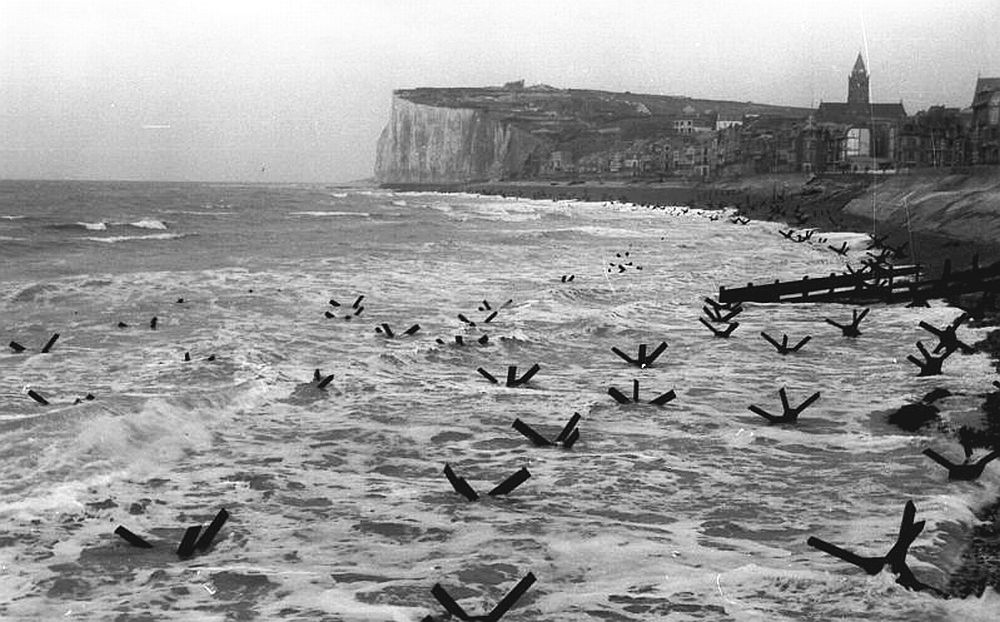
Führer Headquarters
3 November 1943
Top Secret
The Führer
Directive No. 51
For the last two and one-half years the bitter and costly struggle against Bolshevism has made the utmost demands upon the bulk of our military resources and energies. The situation has since changed.
The threat from the East remains, but an even greater danger looms in the West: the Anglo-American landing!
In the East, the vastness of the space will, as a last resort, permit a loss of territory even on a major scale, without suffering a mortal blow to Germany's chance for survival.
Not so in the West! If the enemy here succeeds in penetrating our defenses on a wide front, consequences of staggering proportions will follow within a short time.
For that reason, I can no longer justify the further weakening of the West in favour of other theaters of war. I have therefore decided to strengthen the defenses in the West, particularly at places from which we shall launch our long-range war against England. [V1 flying bombs and rockets] For those are the very points at which the enemy must and will attack; there--unless all indications are misleading--will be fought the decisive invasion battle.
Holding attacks and diversions on other fronts are to be expected. Not even the possibility of a large-scale offensive against Denmark may be excluded.
During the opening phase of the battle, the entire striking power of the enemy will of necessity be directed against our forces manning the coast. Only an all-out effort in the construction of fortifications, an unsurpassed effort that will enlist all available manpower and physical resources of Germany and the occupied areas, will be able to strengthen our defenses along the coasts within the short time that still appears to be left to us.
Stationary weapons (heavy AT guns, immobile tanks to be dug-in, coast artillery, shore-defense guns, mines, etc.) will be heavily concentrated in points of main defensive effort at the most vulnerable coastal sectors.
Should the enemy nevertheless force a landing by concentrating his armed might, he must be hit by the full fury of our counterattack. For this mission ample and speedy reinforcements of men and materiel, as well as intensive training must transform available larger units into first-rate, fully mobile general reserves suitable for offensive operations. The counterattack of these units will prevent the enlargement of the beachhead, and throw the enemy back into the sea.
The anticipated strong attacks by air and sea must be relentlessly countered by Air Force and Navy with all their available resources. I therefore order the following:
The Chief of the Army General Staff and the Inspector General of Panzer Troops will submit to me as soon as possible a schedule covering arms, tanks, assault guns, motor vehicles, and ammunition to be allocated to the Western Front and Denmark within the next three months. That schedule will conform to the new situation. The following considerations will be basic:
Sufficient mobility for all panzer and panzer grenadier divisions in the West, and equipment of each of those units by December 1943 with 93 Mark IV tanks or assault guns, as well as large numbers of antitank weapons.
Accelerated reorganization of the 20 Luftwaffe field divisions into an effective mobile reserve force by the end of 1943. This reorganization is to include the issue of assault guns.
Accelerated issue of all authorized weapons to the SS Panzer Grenadier Division HitlerJugend and the 21st Panzer Division
Additional shipments of Mark IV tanks, assault guns, and heavy AT guns to the reserve panzer divisions stationed in the West and in Denmark.
In November and December, monthly allotments of 100 heavy AT guns models 40 and 43 (half of these to be mobile)
Allotment of large numbers of weapons (including about 1,000 machine guns) for augmenting the armament of those static divisions that are committed for coastal defense in the West and in Denmark.
Ample supply of close-combat AT weapons to units in vulnerable sectors.
Improvement of artillery and AT defenses in units stationed in Denmark, as well as those committed for coastal protection in the occupied West. Strengthening of GHQ artillery.
The units and elements stationed in the West or in Denmark, as well as panzer, assault gun, and AT units to be activated in the West, must not be transferred to other fronts without my permission.
The Chief of the Army General Staff, or the Inspector General of Panzer Troops will submit to me a report through the Armed Forces Operations Staff [headed up by General Alfred Jodl] as soon as the issue of equipment to the panzer and assault gun battalions, as well as to the AT battalions and companies, has been completed.
Beyond similar measures taken in the past, the Commander in Chief West [at the time of this directive, Field Marshal von Rundstedt] will establish timetables for, and conduct maneuvers and command post exercises on, the procedure for bringing up units from sectors not under attack. These units will be made capable of performing offensive missions, however limited. In that connection I demand that sectors not threatened by the enemy be ruthlessly stripped of all forces except small guard detachments. For sectors from which reserves are withdrawn, security and guard detachments must be set aside from security and alarm units.
Pursuant to separate orders, the Chief of Army Equipment and Commander of the Replacement Army will form Kampfgruppen [battle groups] in regimental strength, security battalions, and engineer construction battalions from training cadres, trainees, schools, and instruction and convalescent units in the Zone of the Interior. These troops must be ready for shipment on 48 hours' notice.
signed: Adolf Hitler





































